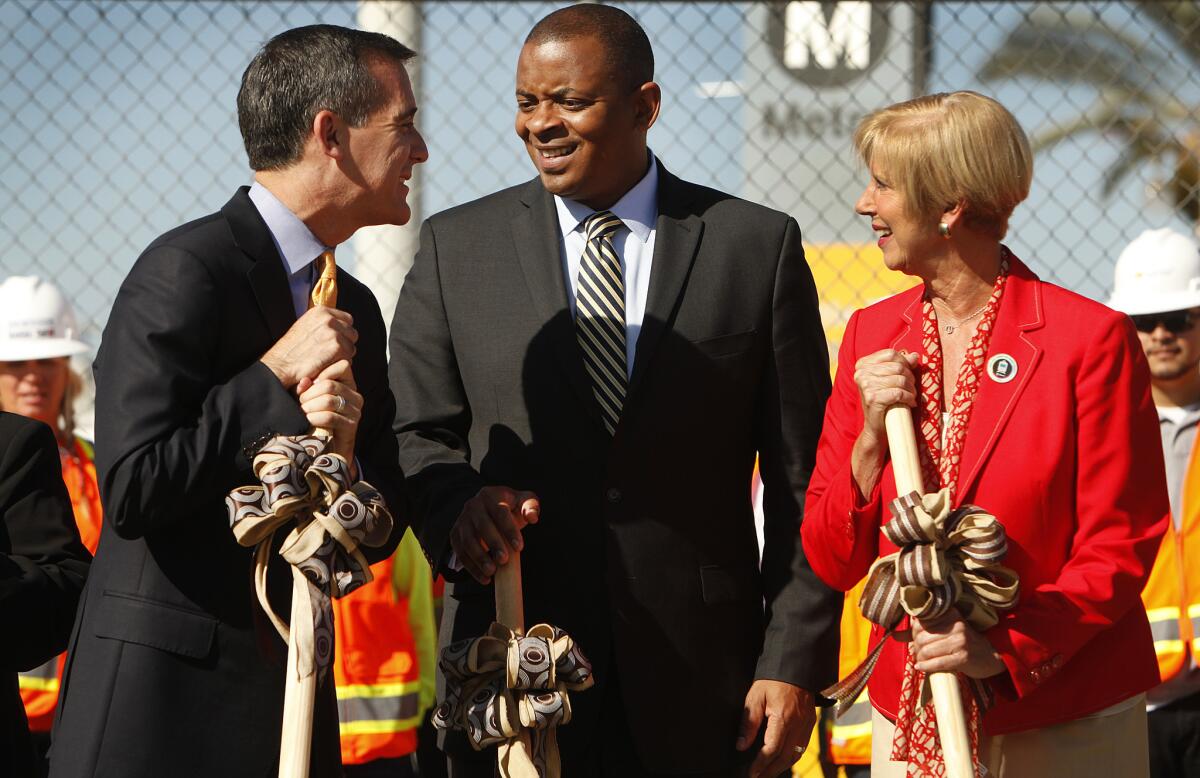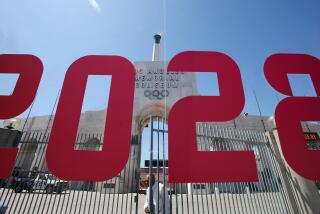Q&A with U.S. Transportation Secretary Anthony Foxx on L.A., Amtrak

Los Angeles Mayor
U.S. Transportation Secretary Anthony Foxx came to Los Angeles on Thursday to urge Congress to keep money flowing for state highway, bridge and transit projects.
In two weeks, unless Congress acts, federal officials’ ability to give money to state and local governments will expire, which could leave road and highway projects across the country in the lurch. The source of that money, the Highway Trust Fund, is expected to go bankrupt sometime this summer.
After a press conference Thursday at a Metropolitan Transportation Authority bus operations facility that received $53 million in federal funding, Foxx talked briefly with The Times and the Associated Press.
He touched on a range of issues, including the future of transportation in Los Angeles and the needs of the Northeast Corridor, the East Coast passenger rail route that saw a fatal derailment Tuesday.
Foxx, who has been Transportation Secretary for the past two years, was previously mayor of Charlotte, N.C.
The transcript has been lightly edited for clarity and concision.
Times: What likelihood do you see for federal funding coming through for California’s high-speed rail?
A: First of all, you’ve got billions already invested in the first phase. I think the more people see it on the ground, that it actually is working…. In the long term, the prospects are really good, but we’ve got to get something in the ground and done. That will help us a lot.
Times: Los Angeles officials are on the verge of asking for another half-cent sales tax increase that could bring in more than $100 billion for more transportation projects. What should this region be focusing on?
A: It’s often the local officials figuring that out. But knowing this city as I do -- you’ve got a relatively constrained road network. There’s only so much more expansion you can do. So this idea of multi-modal investments is probably going to be pretty important. Getting more of your transit system built out, being creative about the use of pedestrian and bicycle facilities, even commuter rail, in some cases.... I think you’ve got some cards to play.
This is a city that really is a poster child for what happens when you get rapid growth, a lot of rapid growth, within a fairly short period of time, and you have a road network that’s basically constrained.
There’s only so much you can do. And you’ve got to think differently about how to move people.
AP: How would you describe the state of infrastructure in the Northeast Corridor, specifically?
We know that we have a huge backlog of maintenance needs in the Northeast Corridor. It’s one of our oldest corridors, and some of the bridges, for example, are more than 100 years old and are badly in need of replacing. We know we need to get the tunnels that connect New Jersey to New York fixed up, and there seems to be some difficulty getting the political momentum to do that.
But these problems are not going away. It’s not like you can stick your head in the sand and they go away tomorrow. They’re going to be there. And you’ve got to own up to them, and figure out a way forward as a country.
I do want to say though, that I want to be careful that we not connect that to the cause of this accident [in Philadelphia], because we’re still trying to figure that out.
AP: Given the importance of that corridor to the nation’s economy, psyche, and everything else, why is there not more money going there? Why is $3 billion going to L.A. [for the Crenshaw Line, the Purple Line extension and the Downtown Regional Connector]? Why isn’t that $3 billion going to the Northeast Corridor?
Well, they’re different programs. We are heavily siloed by virtue of the way Congress has directed the use of expenditures by the [Department of Transportation].
For many years, we’ve just had a crisis of confidence in investments in our rail systems. And, again, as we see more parts of the country densifying, and being constrained, our rail systems are actually a release valve for some of that traffic. And it gives us a different way to get people from one place to another.
We’ve partly made some mistakes over decades, not investing more, and putting our intracity passenger rail system basically on a year-to-year budget, which inhibits its ability to do long-term capital planning and to fix those bridges and those tunnels and do the things we need to do to keep the system strong.
Times: There have been several rail accidents recently that involved at-grade crossings. Do you think there needs to be a national review of at-grade crossings to see what possibly could be done?
Look, I’m all for more grade separations. But that requires an investment, and gets us right back to the same conundrum, which is that there are things that we can do to improve safety at our rail crossings, but it’s going to require some investment from someplace. Right now, we have some resources but not nearly what we need to do more of that.
Times: Where do you think that money could come from?
From Congress. (laughs) That would be a great place for it to come from.
AP: Even though on the Northeast Corridor, there’s a lot of backlog, a lot has been spent. Do you have a sense that it’s been spent well? Have the priorities been proper?
There’s been decades and decades of water under the bridge. What you can say about Amtrak right now is that they have been on a good course in terms of getting their house in order, and shoring up their expenditures, and making sure they get closer to meeting revenues.
But it’s a tough business because the Northeast Corridor on its own is hugely profitable. It’s the rest of the system, that people in rural areas of the country still depend on, that starts to throw the books off-kilter.
If we want to have an intracity passenger rail system in this country, the best way to do it is to have a robust amount of money in place to actually build that system up, and to make it so that there’s more service and more maintenance, not only in the Northeast Corridor, but a system that people all over the country actually want to use.
For more Los Angeles transportation news, follow @laura_nelson on Twitter.
More to Read
Start your day right
Sign up for Essential California for news, features and recommendations from the L.A. Times and beyond in your inbox six days a week.
You may occasionally receive promotional content from the Los Angeles Times.






